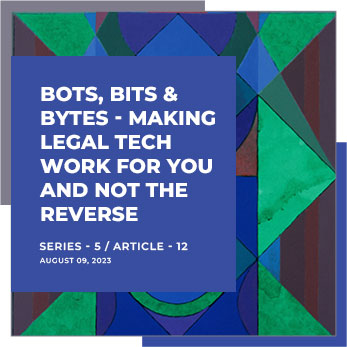“This [ABA] survey is really a follow-up to see how things changed over the course of these last two years in terms of how lawyers are practicing, how we think they are going to continue to practice and while people think COVID is over, our data shows there has been a real shift in terms of how lawyers want to work in the future.”
The COVID-19 pandemic created a paradigm shift as to the definition of ‘workplace’ that cut across almost all businesses and professions.
Among the benefits to come out of the remote work mandate (aside from the health benefit of reduction in exposure to the virus) were such pluses as higher levels of work productivity, fewer work commutes, and an elevated work-family life balance. So far, it sounds like all of the points weigh in favor of the remote work scenario. But as masking and distancing rules became relaxed and the end of the public health emergency was declared, many lawyers decided that the remote work scheme was definitely for them, and they pushed hard to maintain the arrangement. Employers, on the other hand, from government to law firms to private industry, had other ideas. We will examine the current tension between the ‘remotes’ and the ‘in-office’ advocates and where the future of the lawyer’s workplace lies.
Preference for Remote Work Persists
According to an ABA survey, young lawyers feel so strongly about remote work that 44% of them would actually leave their current jobs for a greater ability to work remotely elsewhere. The survey polled about 2,000 ABA members who provided input as to how they are practicing law today as well as what their workplace expectations are as to their employers and their careers in the future. Furthermore, the survey determined that the majority of lawyers are still working remotely, with nearly two-thirds of lawyers in private practice working remotely 100% of the time or pursuant to a flexibility plan allowing them to choose their own schedule. Twenty-three percent responded that they are required to work in the office only one to three days a week.
Similarly, more than half of in-house lawyers can work remotely 100% of the time or make their own schedule, and 32% must work one to three days in the office. Government lawyers experience less flexibility, with only 32% reporting they work fully remote or can choose their own schedule.
Productivity Data
The majority of work-from-home lawyers reported that remote work had not adversely impacted the quality of their work, their productivity, or their billable hours, and for women lawyers in particular, 56% said that remote work was a boon to their ability to balance work and family obligations. As to work-related stresses, most remote-work lawyers reported that remote or hybrid work had either no adverse impact on their ability to deal with stresses or the accommodation increased their ability to handle mental health issues. Yet, all is not rosy, with many respondents also reporting a decrease in professional networking and the quality of relationships with their co-workers, as well as a lack of in-person mentorship that is so valuable to young lawyers seeking to advance their careers.
The Employer’s Push for In-Office
Initially, law firms had to embrace remote working policies just to ensure the continuation of their businesses and to maintain client relationships. However, post-pandemic, these same firms now have to consider the long-term impact that this new operational practice will have on their operations. And their concerns are not without merit: lawyers are highly regulated as to maintaining client confidentiality, and the prospect of having a lawyer spread out files and documents at a home office on an ongoing basis, of course, raises the specter of possible professional responsibility violations.
In addition, there is the cybersecurity exposure given that, in most cases, the remotely working lawyer is using home infrastructure which is not secured to the same extent as an office’s IT system and is quite likely to not have periodic security updates installed. Even during the pandemic, many firms had to expend large sums to invest in VPNs and other costly technology in order to try to safeguard against data leaks. Not every firm can handle that extraordinary budget expense on a permanent basis. Then, there is the client impression factor of not wanting clients to enter offices that appear to be —and in fact, are—empty; this, regardless of the partner’s assurances that top legal talent are poring away over the client’s top-priority file—from home.
Long-term Solutions
As a group, lawyers tend to be resistant to change and to the adoption of innovation, and this tendency poses obstacles in convincing law firms to make the remote-work arrangement permanent. Notwithstanding this professional-cultural trait, solutions have been proposed in the industry that are taking hold in many locales. To begin with, there was a movement towards greater flex-time options for staff even before the pandemic, and therefore having this as a fixture of legal employment is not such a stretch in terms of change. Even the attraction of top legal talent has been enhanced due to the ‘work from anywhere’ phenomenon taking hold across the legal profession, and law firms are aware of this recruiting advantage.
While more traditional Big Law firms have largely brought their staff back in-office—with some firms now operating completely in that manner—other firms have chosen just the opposite track and are now operating on a completely remote-work structure. Somewhere between the two extremes lie hybrid policies that mix in-office, remote-work, and generous flex-time. Accordingly, it can be difficult to pinpoint a real trend across the profession, and only time—and possibly future public crises—will tell what the future holds as the sustainable norm for law firm operations.
Executive Summary
The Issue
How will law firms manage the remote work preference of candidates?
The Gravamen
Young lawyers overwhelmingly prefer the remote work arrangement in their practice of law, and law firms will need to address this preference without compromising on their professional responsibility and cybersecurity obligations.
The Path Forward
Hybrid arrangements are gaining ground, with both hybrid and flex-time structures remaining in place post-pandemic.
Action Items
Data Risk:
The firm’s first responsibility is to the client, and if a firm is going to go fully remote, then safeguards must be put in place to ensure cybersecurity and client confidentiality.
Satisfying the Staff:
No firm wants to experience an exodus of top talent over a poor operational policy, and therefore, management should, at the very least, be attentive to the expressed preferences of their staff.
Budgetary Balance:
While at first, the huge investment in secure cyber infrastructure might seem like an extraordinary expense, consider the fact that such costs may very well be offset by drastic reductions in rent, utilities, and other brick-and-mortar office expenses.
Grasping Change:
Regardless of what the competition has decided to do, the office-only scenario is, in fact, becoming a rarity, and your firm would be wise to come to develop policies that take this seismic workplace change into consideration.
Further Readings
- https://www.lawyer-monthly.com/2022/05/the-future-of-remote-working-in-the-legal-sector/
- https://www.linkedin.com/pulse/future-remote-work-legal-industry-lawmaster-1c
- https://wisetime.com/what-will-remote-working-mean-for-law-firms-in-the-long-term/
- https://www.law2conf.com/blog/impact-remote-work-legal-profession-navigating-challenges-and-opportunities-post-pandemic
- https://www.abajournal.com/web/article/new-aba-report-highlights-lasting-shifts-in-practice-of-law-and-workplace-culture







